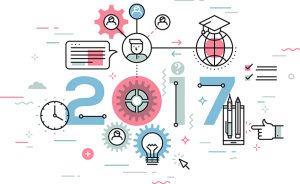
Schools have collaborative learning technologies such as interactive whiteboards that have replaced ancient dusty chalk boards and online homework portals where students always have access to lessons and assignments – the latter being critical for students who missed a class. But there’s even more grandiose technology coming in 2017 and beyond not just because schools have to implement it to keep their classrooms as technologically current as possible, but because of decreasing costs of technological devices and more available funding. This is especially beneficial to urban school districts that previously couldn’t bring innovative technology to their students.
Here’s the technology that I see finding greater favor in educational environments:
Robotics – I believe that K-12 schools and higher education will use robotics for anywhere, anytime learning, whether for students who have to miss school due to an illness and for professors in higher education who can remotely teach from anywhere. Telepresence is currently the hot collaborative technology topic as schools are using Konica Minolta’s game-changing Double Robotics for students and teachers in all levels of education to be present remotely, eliminating physical location as a barrier to learning and teaching. I believe that telepresence – as its exposure grows – will spread like wildfire in the New Year. In higher education, improving students’ problem-solving skills and an emphasis on innovation centers is growing. This will help them better understand and design robotics as they grow older and bring robotics to the generations of students after them.
School of the Future – Administrators will get a lot of technology assistance to help them with their workloads in 2017, including solutions from Konica Minolta’s Workplace of the Future™ portfolio. These solutions, such as our own ALICE Receptionist will appear in both the K-12 and higher education spaces. This visitor management system uses a touch-screen and live video to greet and interact with people when they enter such areas as registrar’s offices and board of education buildings. Expanding its reach in the K-12 market will be such products as our Receptionist for iPad, a simple check-in system that can manage parent and visitor traffic, track visitors and print badges.
Wearable Technology – This is going to get students really jazzed and more engaged in their lessons. It refers to any device that can be worn, such as headsets, fitness trackers and smartwatches. Google Expeditions opened the door for students to not only read about foreign lands, but walk those landscapes remotely with a headset provided by the school. Productivity wristbands have proven beneficial for physical education classes and, as their functionality and accuracy increase, they will greatly help coaches elevate student athletes’ abilities. I believe that wearable technologies will increase students’ interest in the science, technology, engineering and mathematics (STEM) disciplines in K-12. In higher education, there’s a whole host of uses, such as in science, pre-med and at medical schools.
Virtual Reality and Augmented Reality – Imagine a teacher reading the story of “Puff, the Magic Dragon” to children, but instead of them seeing Puff’s static picture in a book, they’re interacting with a friendly dragon right in their classroom via a headset! This is possible with augmented reality. While virtual reality creates a completely contained digital experience, augmented reality overlays digital graphics on top of the real world, creating a wondrous world in which students will find learning an absolutely amazing experience. Technological advances will continue to make the augmented world so real that students will want to stay in it longer. Think about it: Wouldn’t you prefer that your child be amazed by walking on the moon in the safety of their classroom or bedroom rather than hanging out on a street corner vulnerable to the elements? This holds true for higher education as well, but with a degree of sophistication. Engineering and architectural departments, biology and chemistry courses as well as medical schools will see an increased use of this technology, too, whereby students can “walk through” an architect’s conception of a proposed building or “peer into” a patient’s body during surgery.
Adaptive Learning/Personalized Learning – With this, K-12 students can determine their own individual learning goals and work at their own pace to achieve them. This prediction is easy because it’s one technology area that is witnessing a significant increase in funding as its popularity continues to grow. In higher education technology, I believe we’ll see more personalized learning as students are mature enough to be able to use online self-assessment tools to measure their own progress, making them accountable for their own success and increasing their self-confidence as they achieve personal education goals.
Redesign of Learning Spaces – Creating a K-12 digital classroom encompasses two primary elements: The ability to support the latest technology and healthier environments. This area will grow exponentially as prices drop on personal devices, allowing even low-income families to arm their children with these critical learning tools. Our IT Services division, All Covered, is helping to create the classroom of the future with such elements as bring your own device (BYOD) solutions so that teachers can communicate with their students who, as we know, love their smartphones and tablets. Outside the classroom, the growth of a digital learning ecosystem — which connects students, teachers, parents and administrators to produce a productive and safe insular world of communications – will become even more viable thanks, again, to dropping prices for connectable gadgets and more funding for school districts.
Technology has made the future of education very exciting as well as more collaborative and inclusive – and there’s a long way to go as advances in it continue to escalate in short periods of time. As a Konica Minolta employee and an educator, I’m happy to be an eyewitness to this great revolution that’s positively affecting education. Educational technology will continue to prove to be a crucial bridge for teachers to effectively connect with and educate their students.